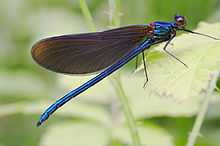Calopterygidae
| Calopterygidae | |
|---|---|
 | |
| Calopteryx virgo | |
| Scientific classification | |
| Kingdom: | Animalia |
| Phylum: | Arthropoda |
| Class: | Insecta |
| Order: | Odonata |
| Suborder: | Zygoptera |
| Family: | Calopterygidae Sélys, 1850 |
| Subfamilies | |
| |
The Calopterygidae are a family of damselflies (Zygoptera), commonly known as demoiselles or jewelwings. These rather large damselflies have wingspans of 50–80 mm (compared to about 44 mm in the common bluetail damselfly, Ischnura elegans) and are often metallic-coloured. The family contains some 150 species.
The Calopterygidae are found along the banks of permanent but slow-flowing streams, often with thick vegetation and debris.
Etymology
The name is derived from Greek kalos meaning beautiful and ptery meaning winged.
Characteristics
The adults have metallic bodies; their wings are broader, with wider bases than other damselflies, and at rest hold their wings parallel to the body, slightly elevated. Some species have conspicuously colored wings; in males, the wings are usually blue, without pterostigmas, in females green or brown. The wings are heavily veined, having often 18 or more antenodal veins. They have a jerky, skipping form of flight and they perch horizontally on twigs near the water edge. The first segment of their antennae is longer than the combined length of the other segments.[1][2]
Calopterygidae nymphs have lateral gills are longer than the median gills.[3]The nymphs have a flattened, pentagonal-shaped head, a long first antennal segment and long legs. They are found among submerged aquatic plants, woody debris and the exposed roots of streamside plants. There is a single generation per year.[2]
Classification
Subfamily Caliphaeinae Tillyard & Fraser, 1939:
- Caliphaea Hagen in Selys, 1859
- Noguchiphaea Asahina, 1976
Subfamily Calopteryginae Selys, 1859:
- Archineura Kirby, 1894
- Atrocalopteryx Dumont, Vanfleteren, De Jonckheere, & Weekers, 2005
- Calopteryx Leach, 1815
- Echo Selys, 1853
- Iridictyon Needham & Fisher, 1940
- Matrona Selys, 1853
- Mnais Selys, 1853
- Neurobasis Selys, 1853
- Phaon Selys, 1853
- Psolodesmus McLachlan, 1870
- Sapho Selys, 1853
- Umma Kirby, 1890
- Vestalis Selys, 1853
Subfamily Hetaerininae Selys, 1853:
See also
| Wikispecies has information related to: Calopterygidae |
| Wikimedia Commons has media related to Calopterygidae. |
References
- ↑ Dijkstra, 2006. Pages 23, 65.
- ↑ 2.0 2.1 John L. Capinera (2008). Encyclopedia of Entomology. Springer Science & Business Media. pp. 1243–1244. ISBN 978-1-4020-6242-1.
- ↑ "UNH Center for Freshwater Biology".
Sources
- Dijkstra, Klaas-Douwe B. (2006). Field Guide to the Dragonflies of Britain and Europe. British Wildlife Publishing. ISBN 0-9531399-4-8.
- Schorr, Martin; Lindeboom, Martin; Paulson, Dennis. "World Odonata List". University of Puget Sound. Retrieved 11 August 2010.
| ||||||||||||||||||||||||||||||||||||||||||||||||||||||||||